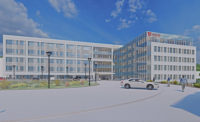Dr. David Rempel led a team of researchers from the University of California in San Francisco and Berkeley that developed an “inverted” drill press. The tool cuts the stress that overhead drilling can create on a construction worker’s shoulders, arms and hands by nearly 90%, without losing any productivity.
A physician, professor and head of the UCSF ergonomics program, Rempel directed the research team throughout five years of developing and field-testing the inverted drill press with construction workers in California, Oregon and Washington.
The device consists of a tripod base on locking wheels, a telescoping vertical column with a drill-mounting saddle on top, alignment devices, and handwheels and gears that extend and retract the column. It weighs about 45 lb, can be assembled on-site in about 30 seconds and is compatible with personnel lifts.
Electricians, plumbers, carpenters, sheet-metal workers and laborers drill thousands of overhead holes each year for anchor bolts that hold up pipes, conduit, cable trays, ducts, struts and ceiling-mounted equipment. The drill press enables construction workers to drill holes into concrete or metal ceilings while they are standing on the ground, not standing on a ladder.
Normal drilling by hand requires workers to reach overhead and push upward with 55 lb of force. “We wanted to reduce the wear and tear and associated musculoskeletal disease for workers doing this task,” says Rempel.
Consider the job. “It’s like holding a noisy, vibrating 50-lb box above your shoulders while dust drops into your face and eyes—while you’re standing on a ladder,” Rempel explains. Drilling with the handwheel-operated drill press that his team invented takes only 5.8 lb of force, which amounts to an 89.5% reduction.
An alignment system also eliminates the need to climb a ladder to mark hole locations before drilling. Each inverted drill press currently costs about $1,000 for components and $3,000 in labor to build.
Rempel says a manufacturer is now evaluating whether to take the inverted drill press to market as a commercial product, and the research team is working on a larger model to handle the heavier drills used to put overhead holes in highway bridges, overpasses and rock. The research is funded by the Center for Construction Research and Training through a grant from the National Institute for Occupational Safety and Health.


Post a comment to this article
Report Abusive Comment